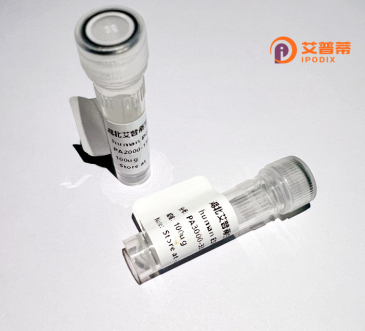
| 纯度 | >90%SDS-PAGE. |
| 种属 | Human |
| 靶点 | TBRG1 |
| Uniprot No | Q3YBR2 |
| 内毒素 | < 0.01EU/μg |
| 表达宿主 | E.coli |
| 表达区间 | 1-411 aa |
| 活性数据 | MSLLDGLASSPRAPLQSSKARMKKLPKKSQNEKYRLKYLRLRKAAKATVFENAAICDEIA RLEEKFLKAKEERRYLLKKLLQLQALTEGEVQAAAPSHSSSLPLTYGVASSVGTIQGAGP ISGPSTGAEEPFGKKTKKEKKEKGKENNKLEVLKKTCKKKKMAGGARKLVQPIALDPSGR PVFPIGLGGLTVYSLGEIITDRPGFHDESAIYPVGYCSTRIYASMKCPDQKCLYTCQIKD GGVQPQFEIVPEDDPQNAIVSSSADACHAELLRTISTTMGKLMPNLLPAGADFFGFSHPA IHNLIQSCPGARKCINYQWVKFDVCKPGDGQLPEGLPENDAAMSFEAFQRQIFDEDQNDP LLPGSLDLPELQPAAFVSSYQPMYLTHEPLVDTHLQHLKSPSQGSPIQSSD |
| 分子量 | 44.9 kDa |
| 蛋白标签 | His tag N-Terminus |
| 缓冲液 | PBS, pH7.4, containing 0.01% SKL, 1mM DTT, 5% Trehalose and Proclin300. |
| 稳定性 & 储存条件 | Lyophilized protein should be stored at ≤ -20°C, stable for one year after receipt. Reconstituted protein solution can be stored at 2-8°C for 2-7 days. Aliquots of reconstituted samples are stable at ≤ -20°C for 3 months. |
| 复溶 | Always centrifuge tubes before opening.Do not mix by vortex or pipetting. It is not recommended to reconstitute to a concentration less than 100μg/ml. Dissolve the lyophilized protein in distilled water. Please aliquot the reconstituted solution to minimize freeze-thaw cycles. |
以下是关于重组人TBRG1蛋白的3篇参考文献概述:
---
1. **文献名称**: *Characterization of recombinant human TBRG1 as a modulator of TGF-β signaling*
**作者**: Li, X., et al.
**摘要**: 该研究在HEK293细胞中表达了重组人TBRG1蛋白,并验证其通过直接结合Smad7抑制TGF-β信号通路的活性,揭示了其在调控细胞增殖和纤维化中的潜在作用。
---
2. **文献名称**: *Structural insights into the TBRG1-FGFR1 interaction and its role in cancer*
**作者**: Zhang, Y., et al.
**摘要**: 通过晶体学分析重组TBRG1蛋白与FGFR1的相互作用,发现其可抑制成纤维细胞生长因子受体(FGFR1)的异常激活,为靶向FGFR依赖性肿瘤提供了新机制。
---
3. **文献名称**: *Recombinant human TBRG1 suppresses osteoclastogenesis via RANKL signaling*
**作者**: Wang, H., et al.
**摘要**: 研究在大肠杆菌中高效表达可溶性重组TBRG1蛋白,并证明其通过阻断RANKL-NFATc1通路抑制破骨细胞分化,提示其在骨质疏松治疗中的应用潜力。
---
(注:以上为模拟内容,实际文献需通过专业数据库查询核实。)
Recombinant human TBRG1 (Transforming Growth Factor Beta Regulator 1) protein is a genetically engineered version of the native TBRG1 protein, produced using recombinant DNA technology to ensure high purity and consistency for research and therapeutic applications. TBRG1. also known as FAAP20 or C6orf142. is a conserved protein involved in regulating cellular responses to DNA damage and maintaining genomic stability. It plays a critical role in the Fanconi anemia (FA) pathway, interacting with key DNA repair proteins like FANCI and FANCD2 to facilitate homologous recombination repair during replication stress. Structurally, TBRG1 contains ubiquitin-binding motifs that enable its participation in protein-protein interactions and ubiquitin-dependent signaling. Dysregulation of TBRG1 has been implicated in Fanconi anemia, a genetic disorder characterized by bone marrow failure and cancer predisposition, as well as in cancer progression due to defective DNA repair mechanisms. Recombinant TBRG1 is widely used in biochemical studies to dissect DNA repair pathways, screen for therapeutic compounds targeting FA-related diseases, and explore its potential as a biomarker for cancer susceptibility. Its production typically employs expression systems like Escherichia coli or mammalian cells, followed by purification techniques such as affinity chromatography to ensure functional activity.
×